Zone
Crash of a Fokker F27 Friendship 500RF in Sligo
Date & Time:
Nov 2, 2002 at 1702 LT
Registration:
G-ECAT
Survivors:
Yes
Schedule:
Dublin - Sligo
MSN:
10672
YOM:
1984
Flight number:
ECY406
Crew on board:
4
Crew fatalities:
Pax on board:
36
Pax fatalities:
Other fatalities:
Total fatalities:
0
Captain / Total hours on type:
1176.00
Copilot / Total hours on type:
787
Aircraft flight hours:
27452
Circumstances:
The aircraft, a Fokker F27-500, registration G-ECAT, departed Dublin at 16.05 hrs (local time) for the 4th leg of a Public Service Obligation (PSO) rotation between Sligo in the North West of Ireland and Dublin. The aircraft had earlier departed Sligo for Dublin at 10.00 hrs, returned to Sligo at 12.30 hrs and departed once again for Dublin on time at 14.30 hrs. The Operator held the PSO contract to provide regular air service between Sligo and Dublin and also between Donegal (EIDL) and Dublin. The accident flight was delayed for 10 minutes as the flight to Donegal had been cancelled due to strong crosswinds at Donegal and arrangements had been made to fly these passengers to Sligo and bus them onwards to Donegal. The en-route segment of this flight was uneventful. At 16.22 hrs G-ECAT called Sligo on Tower frequency 122.10 Mhz and requested the latest weather conditions for Sligo. The Tower Controller transmitted the 16.30 hrs actual for Sligo, as presented at Section 1.7 Meteorological Information. At 16.50 hrs, the aircraft was handed over from Shannon Control to Sligo Tower, descending to 3,500 ft to the SLG beacon for NDB/DME approach to RWY 11. Sligo Tower then transmitted the Donegal weather, as presented at Section 1.7 Meteorological Information. At 16.53 hrs, the aircraft called overhead the SLG beacon and was cleared by Sligo Tower for the approach. At 17.00 hrs, G-ECAT reported at the Final Approach Fix (FAF) and was cleared to land by the Tower, giving a wind of 120 degrees 15 kt, gusting 29 kt. At 17.01 hrs, just prior to landing, G-ECAT was given a wind check of 120 degrees 15 kt, gusting 31 kt. At 17.02 hrs the aircraft made an initial touchdown at approximately the mid-point of the runway and appeared to a number of witnesses not to immediately decelerate. The aircraft continued down the runway until it departed the paved surface at the right hand side of the threshold of RWY 29. On seeing the aircraft pass the apron taxiway/runway intersection at an abnormally high speed, the Tower Controller immediately sounded the crash alarm. The aircraft continued on through a prepared run-off area at the end of the runway, for a further 50 metres, before coming to rest (17.02:30 hrs) with the main wheels embedded in boulders that formed part of an embankment leading down to the sea. The main wheels were approximately one metre short of where the boulders fall away into the sea. The nose wheel, cockpit and forward section of the fuselage cleared the top of the boulder embankment and the aircraft tilted approximately 15-20 degrees nose down onto the outgoing tide. Full tide was due at 04.00 hrs the following day at a depth of 3.9 meters. The Tower Controller immediately contacted the Shannon ATC Station Manager advising of the runway excursion and called 999 to request Gardaí, Fire Brigade and Ambulance assistance.
Probable cause:
The probable cause of this accident was a fast, low approach, leading to the aircraft landing late, beyond the normal touch down point, thereby making it impossible to stop the aircraft on the remaining runway available.
Contributory cause:
1. The lack of an adequate overrun area before an aircraft, failing to stop on the runway, enters the sea.
2. The lack of experience of the Operator in scheduled air operations.
3. The changing operational management structure and uncertain nature of the direction of the company with regard to aircraft type and network development.
Contributory cause:
1. The lack of an adequate overrun area before an aircraft, failing to stop on the runway, enters the sea.
2. The lack of experience of the Operator in scheduled air operations.
3. The changing operational management structure and uncertain nature of the direction of the company with regard to aircraft type and network development.
Final Report:
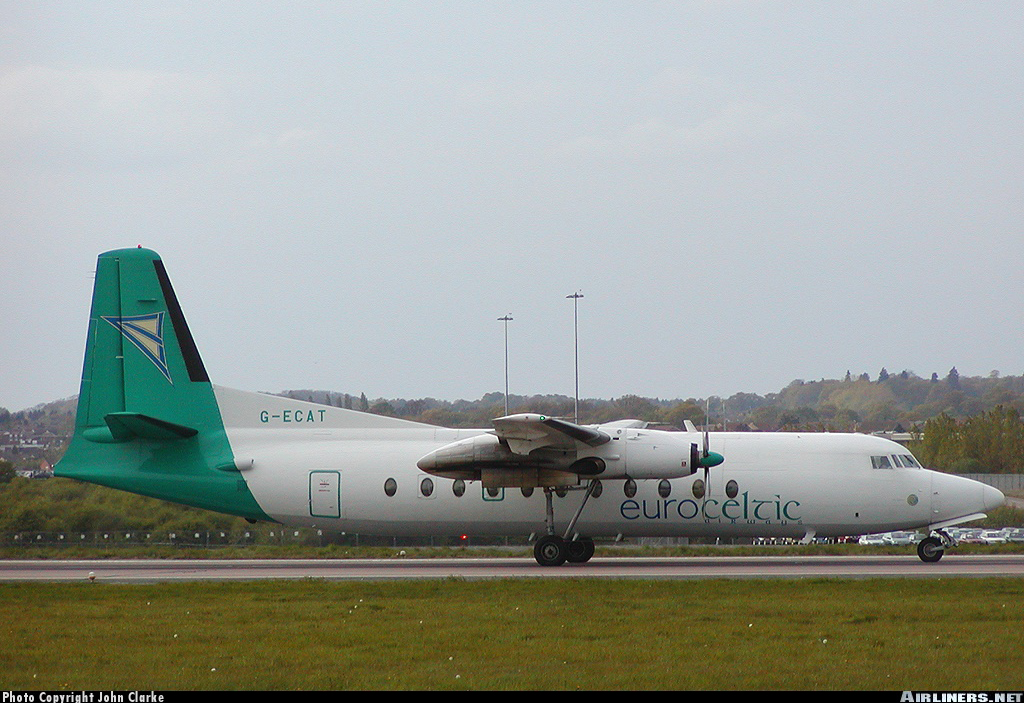
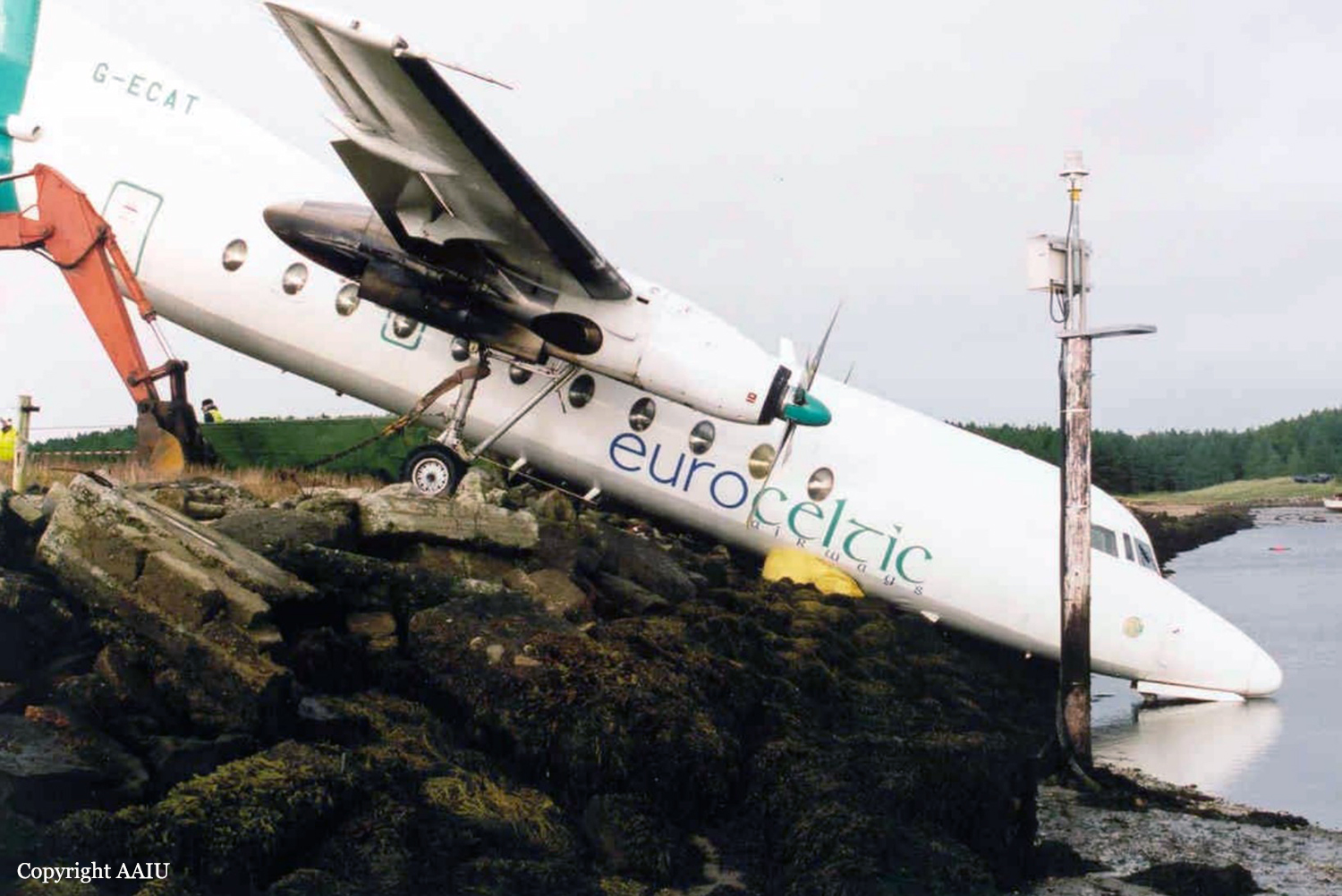
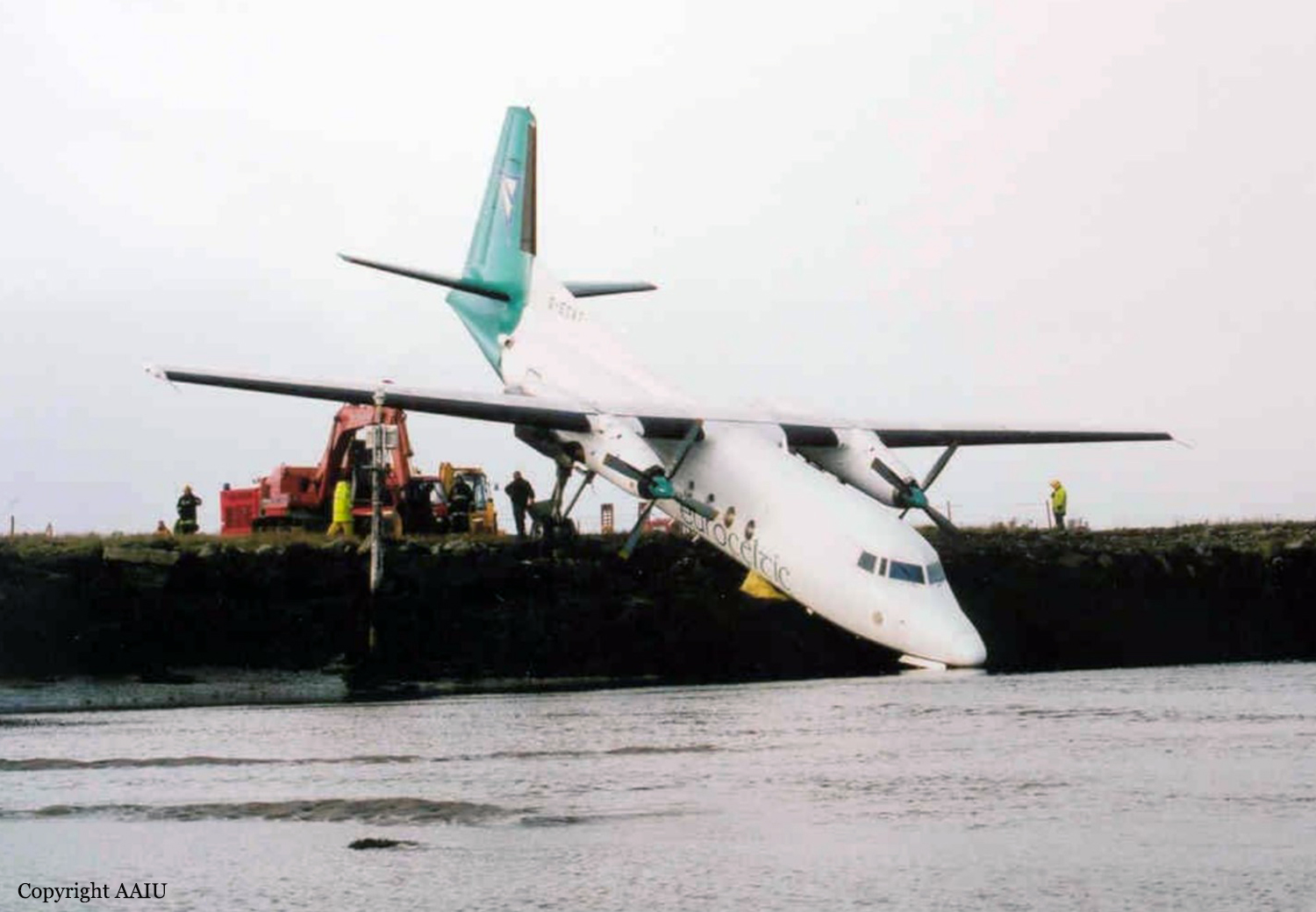
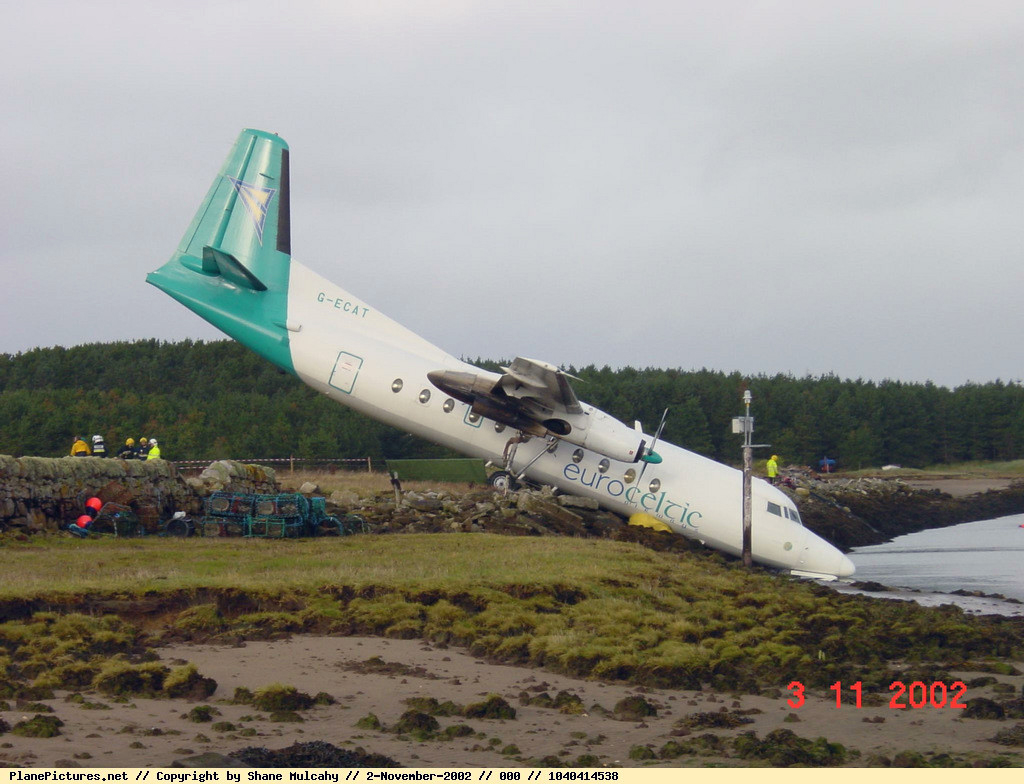
Crash of a Short 360-100 in Sheffield
Date & Time:
Feb 4, 2001 at 1921 LT
Registration:
EI-BPD
Survivors:
Yes
Schedule:
Dublin – Sheffield
MSN:
3656
YOM:
1984
Crew on board:
3
Crew fatalities:
Pax on board:
25
Pax fatalities:
Other fatalities:
Total fatalities:
0
Captain / Total hours on type:
1392.00
Circumstances:
The crew were planned to fly a scheduled passenger flight from Dublin to Sheffield airport and the commander was the handling pilot for the flight. Both pilots had operated into Sheffield between five and ten times in the previous three months. The aircraft, which was serviceable, took off from Dublin at 1814 hrs and was routed to Sheffield via the VOR/DME navigation beacon at Wallasey at FL90. Prior to descent, the crew obtained the most recent information from the Automatic Terminal Information Service (ATIS); this report, timed at 1820 hrs, was identified as 'Information Hotel'. The reported conditions at Sheffield were: surface wind variable at 03 kt, visibility 4,000 metres in rain and snow, a few clouds at 600 feet, scattered cloud at 1,200 feet and broken cloud at 3,000 feet, the temperature and dew point were coincident at +1°C and the QNH was 989 hPa. Air traffic control was passed to the Sheffield approach controller when the aircraft was 12 nm from the overhead at which time it was descending to 5,000 feet on the QNH. The crew were informed that the current ATIS was now 'Information India' and the aircraft was cleared to descend to 3,000 feet when within 10 nm of the airport. 'Information India', timed at 1850 hrs, contained no significant changes from 'Information Hotel'. The aircraft weight for the landing was calculated to be 11,100 kg with an associated threshold speed of 103 kt. The aircraft was cleared for the ILS/DME procedure for Runway 28 and the crew requested the QFE which was 980 hPa. The decision height for the approach was 400 feet. During the initial stages of the manually flown ILS approach the commander's flight director warning flag appeared briefly but then disappeared and did not reappear during the remaining period of flight. The de-ice boots had been selected to 'ON' early in the descent when the aircraft had briefly encountered light icing. These de-ice boots were selected to 'OFF' when at 5 nm from the runway at which stage there were no indications of icing and the indicated outside air temperature was +5°C. (This is indicative of an actual air temperature of +2°C.) At 1918:11 hrs the crew reported that they were established on the localiser. When the aircraft intercepted the glidepath, the flaps were set to 15° correctly configuring the aircraft for the approach. The handling pilot recalled that initially the rate of descent was slightly higher than the expected 650 ft/min leading him to suspect the presence of a tailwind, however, the rate of descent returned to a more normal value when approximately 4 nm from the runway. The propellers were set to the maximum rpm at 1,200 feet agl. When the crew reported that they were inside 4 nm they were cleared to land and passed the surface wind, which was variable at 2 kt; they were also warned that the runway surface was wet. Both pilots saw the runway lights when approaching 400 feet agl; the flaps were selected to 30° and confirmed at that position. Both pilots believed that the airspeed was satisfactory but, as the commander checked back on the control column for the landing, the rate of descent increased noticeably and the aircraft landed firmly. Both pilots believed that the power levers were in the flight idle position and neither was aware of any unusual control inputs during the landing flare. Two separate witnesses saw the aircraft during the later stages of the approach and the subsequent landing, one of these witnesses was in the control tower and the other was standing in front of the passenger terminal. They both saw the aircraft come into view at a height of approximately 400 feet and apparently travelling faster than normal. They described the aircraft striking the ground very hard with the left wing low; both heard a loud noise coincident with the initial contact. They then reported that the aircraft bounced before hitting the ground again, this time with the nose wheel first, before bouncing once more. Crew statements and flight data evidence indicate that the aircraft lifted no more than 8 feet before settling on the runway and then remained on the ground. The aircraft was then seen to travel about half way along the runway before slewing to the left and running onto the grass. When the aircraft stopped the left wing tip appeared to be touching the grass. When the aircraft came to rest the tower controller asked the crew if they required assistance, this call was timed at 1921:15 hrs. The crew asked for the fire services to be placed on standby but the controller judged that the situation required an immediate and full emergency response and activated the fire and rescue services. The airfield fire services arrived at the aircraft at 1924 hrs and all the passengers had been evacuated by 1925 hrs. The South Yorkshire fire and rescue services arrived at 1933 hrs and assisted in ferrying passengers to the terminal building.
Probable cause:
Evidence from the CVR indicated that the flight was conducted in a thoroughly professional manner in accordance the operator's normal procedures until the final stages of the approach. The recorded data indicate that three seconds prior to touchdown the propeller blade angle changed from the flight range to the ground range. Coincident with this change the CVR recorded sounds consistent with the propellers 'disking' and the FDR indicated that the aircraft then decelerated longitudinally and accelerated downwards. The engineering investigation revealed that the propeller control rigging and the operation of the flight idle baulk were correct. Selection of ground fine requires the pilot to firstly release the flight idle baulk and then lift and pull the propeller levers further back, this combined action rapidly becomes a programmed motor skill in the routine of daily operations. It is therefore possible that the handling pilot unintentionally selected the propellers into the ground fine position whilst still in the air.
Final Report:
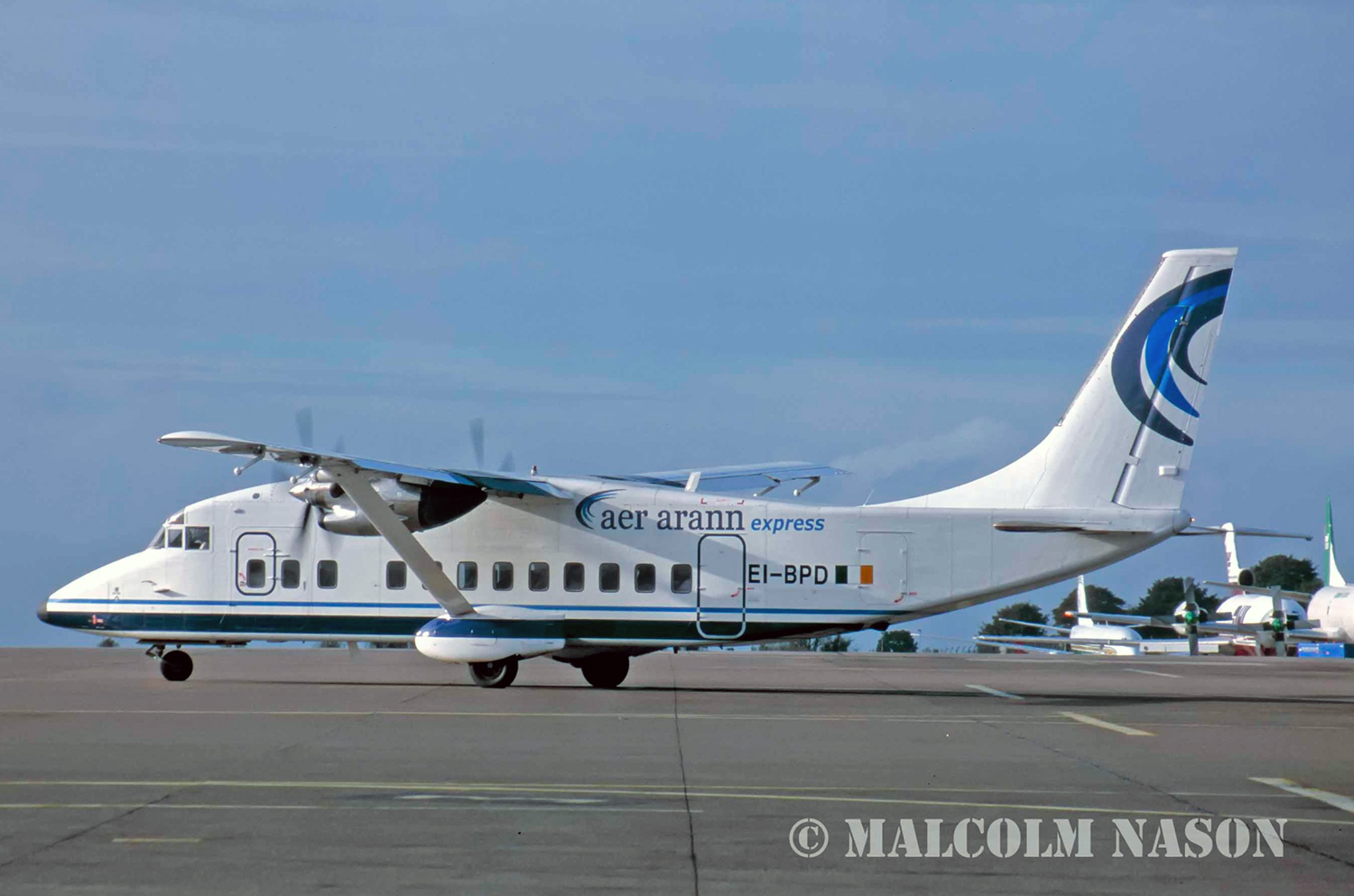
Crash of a Lockheed L-188AF Electra in Shannon
Date & Time:
Mar 1, 1999 at 0846 LT
Registration:
N285F
Survivors:
Yes
Schedule:
Cologne - Dublin - Shannon
MSN:
1107
YOM:
1959
Flight number:
EXS6526
Crew on board:
3
Crew fatalities:
Pax on board:
0
Pax fatalities:
Other fatalities:
Total fatalities:
0
Captain / Total hours on type:
3200.00
Copilot / Total hours on type:
760
Aircraft flight hours:
65000
Circumstances:
The aircraft (Flight 6526) departed Cologne at 0300 hours and routed directly to Dublin, where, after more than one hours delay due to the late arrival of a freight truck, the aircraft departed for Shannon Airport at 0816 hours. The crew consisted of the First Officer who was the handling pilot on both of these sectors, the Captain who was the non-handling pilot and the Flight Engineer. The take off gross weight was estimated at 83,701 lbs, well below the limiting 116,000 lbs take off weight (MTOW), and the centre of gravity was within limits. The landing weight was estimated at 80,345 lbs, again below the maximum landing weight of 98,102 lbs. The total freight on board was 14,000 lbs, less than half the 33,000 lbs maximum amount permissible. The aircraft reached it's designated altitude of FL120. The crew were handed over to Shannon Approach and given descent clearance. Shannon Approach instructed the crew to keep the speed up (due to an another aircraft behind them) and the aircraft was vectored on an approach to RWY 24. Due to the weather forecast for Shannon the crew decided to conduct the landing with 78% flaps set, rather than the standard 100% flap normally set for landing. During the approach the Captain called 1000 ft above the touchdown zone (TDZ), then 500 ft and every 100 ft thereafter to the Decision Altitude (DA). At an altitude of 700 ft the Ground Proximity Warning (GPWS) horn sounded. The Flight Engineer proceeded to inhibit the GPWS system. Slowing the aircraft to Vma (Maximum Manoeuvering Airspeed) the crew did not carry out the "before landing" checks. Whilst over the RWY threshold the gear warning horn sounded and five seconds later the crew heard a scraping sound and felt severe aircraft vibrations. Realising that the gear was not down the Captain called for a go-around. The First Officer continued to fly the aircraft and was cleared to 3000 ft by ATC. However, during the climb out the aircraft flew into cloud (Instrument Meteorological Conditions) at about 500/600 feet, and simultaneously the propeller assembly and part of No. 3 engine fell to the ground. Electrical power was lost and the only serviceable flight instruments available to the crew was the standby artificial horizon and wet compass. The First Officer relinquished control of the aircraft to the Captain who had great difficulty in maintaining directional control and it took the combined efforts of both pilots to control the excessive yaw through the rudder pedals. In addition, there was insufficient power available to climb to 3000 ft. In fact, less than 2000 ft was attained, as the aircraft commenced a slow difficult turn in a North Easterly direction and towards the high ground west of Limerick city. It was only by further manipulation of the throttles and feathering No. 4 engine that sufficient directional control was recovered, enough to respond to the instructions of the ATC Radar operator. The aircraft was now flying with only No.1 engine fully operative and No. 2 engine producing only half power and much vibration. The Radar operator vectored the aircraft to approach RWY 24 which became visible to the crew. They selected "gear down" and while only 2 of the 3 green landing lights illuminated, the Captain elected to proceed with the landing, with the flaps again set at 78%. This landing was successful, with all the landing gear deploying correctly. The aircraft was evacuated while the airport crash crews stood by.
Probable cause:
The primary responsibility for the safe conduct of a flight rests with the cockpit crew and, in this regard, they have the Aircraft Flight Manual (AFM), company Standard Operating Procedures (SOP's) and other technical manuals at their disposal in the cockpit. In particular, the company lays down the SOP's to be followed by each and every cockpit crew member in the interests of standardisation and flight safety. The implementation of these measures and procedures is carried out by the cockpit crew and they are aided in this process by artificial mechanical/electrical warning systems and audio alerts. In the L188 in question the two audio alert systems consist of a Ground Proximity Warning System (GPWS) and the landing gear warning horn. The GPWS system sounded at about 700' AGL and this should have been sufficient to warn the crew that the landing gear handle was not down and consequently that the undercarriage was not in the landing configuration. The Flight Engineer, however, reached up and inhibited the GPWS. He said he did this because he understood the aircraft to have 78% flap set for landing and that this was why the GPWS warning sounded. He obviously confused this warning with a warning which he would have got below 200 feet radio height when the flaps are set at less than 100% for landing. The fact that this particular aircraft had no FLAP OVERRIDE switch, as the other two similar aircraft in the fleet had, would probably have added to this confusion. Whether the engineer was instructed to inhibit the GPWS by other crew members is not clear from the CVR. In the debrief following the accident the other crew members agreed that the engineer would have been correct in inhibiting the GPWS as they were landing with 78% flaps configuration. They, therefore, also misinterpreted the GPWS warning. Having failed to carry out the landing checks and with the undercarriage not down, the normal undercarriage warning horn should have sounded when the throttles were retarded for landing. However, it is possible to silence this warning in the 78% flap configuration, which would not have been possible if the flaps were set in the normal (100%) configuration for landing. It appears that as the throttles were being retarded the Flight Engineer pressed the warning horn button to prevent the alarm from sounding. Whether he was so instructed is not clear as parts of the CVR tape were difficult to interpret due to its poor quality. During the final stage of landing the throttles were advanced again thus negating the warning cancellation. As the aircraft rounded out for landing the warning horn was again free to sound, and it did, as the throttles were retarded. However, at this stage, there was too little time to lower the undercarriage and five seconds later the propellers stuck the runway surface.
The following findings were identified:
- The aircraft had a valid standard Airworthiness Certificate issued by the United States Department of Transportation, Federal Aviation Administration and had been maintained in accordance with an approved schedule.
- No evidence was found of any technical problems on the aircraft, or its systems, that could have had any bearing on the accident. In addition, the aircraft records show that the aircraft was dispatched on the accident flight with no deferred maintenance items.
- The crew were properly licensed, in accordance with US Federal Aviation Administration Regulations, to undertake this flight.
- The Captain stated that he had slight flu symptoms over the two days prior to the flight but that did not disbar him from undertaking the flight.
- The flight crew consisted of the Captain, First Officer and Flight Engineer. The First Officer was the handling pilot on this flight.
- No emergency call was made to ATC by the Captain or First Officer. The Shannon Radar controller provided invaluable voice and directional assistance to the crew as they struggled to maintain control of their seriously damaged aircraft and this was subsequently acknowledged by the crew.
- The subsequent actions of the crew in landing the aircraft safely from the second approach were commendable.
- The ILS for RWY 24 was fully serviceable.
- Crew fatigue is not considered a factor in this accident as they had sufficient time off duty in the days immediately prior to the flight and their overall flying duties are of average industry standards.
- Debris from the disintegrating No. 3 engine fell to earth on the western side of RWY 24, within the boundaries of Shannon Airport. Fortunately, there was no damage to property or people.
- The selection of 78% flap setting for the landing was in accord with the Operators SOP's for the prevailing landing conditions. However in selecting 78% flap setting the crew were of the mistaken opinion that the GPWS warning horn should be silenced even though the aircraft was not in the landing configuration.
- The Flight Engineer silenced the landing gear warning horn during the approach phase while the engine power levers were being retarded. It is only when these levers were slightly advanced, just before the round-out stage, that the landing warning horn system was again primed and subsequently sounded.
- The normal landing checks were not carried out by the flight crew. Not one crew member realised that the undercarriage gear was not down and locked.
- The crew stated that this was an inexplicable oversight on their part.
The following findings were identified:
- The aircraft had a valid standard Airworthiness Certificate issued by the United States Department of Transportation, Federal Aviation Administration and had been maintained in accordance with an approved schedule.
- No evidence was found of any technical problems on the aircraft, or its systems, that could have had any bearing on the accident. In addition, the aircraft records show that the aircraft was dispatched on the accident flight with no deferred maintenance items.
- The crew were properly licensed, in accordance with US Federal Aviation Administration Regulations, to undertake this flight.
- The Captain stated that he had slight flu symptoms over the two days prior to the flight but that did not disbar him from undertaking the flight.
- The flight crew consisted of the Captain, First Officer and Flight Engineer. The First Officer was the handling pilot on this flight.
- No emergency call was made to ATC by the Captain or First Officer. The Shannon Radar controller provided invaluable voice and directional assistance to the crew as they struggled to maintain control of their seriously damaged aircraft and this was subsequently acknowledged by the crew.
- The subsequent actions of the crew in landing the aircraft safely from the second approach were commendable.
- The ILS for RWY 24 was fully serviceable.
- Crew fatigue is not considered a factor in this accident as they had sufficient time off duty in the days immediately prior to the flight and their overall flying duties are of average industry standards.
- Debris from the disintegrating No. 3 engine fell to earth on the western side of RWY 24, within the boundaries of Shannon Airport. Fortunately, there was no damage to property or people.
- The selection of 78% flap setting for the landing was in accord with the Operators SOP's for the prevailing landing conditions. However in selecting 78% flap setting the crew were of the mistaken opinion that the GPWS warning horn should be silenced even though the aircraft was not in the landing configuration.
- The Flight Engineer silenced the landing gear warning horn during the approach phase while the engine power levers were being retarded. It is only when these levers were slightly advanced, just before the round-out stage, that the landing warning horn system was again primed and subsequently sounded.
- The normal landing checks were not carried out by the flight crew. Not one crew member realised that the undercarriage gear was not down and locked.
- The crew stated that this was an inexplicable oversight on their part.
Final Report:
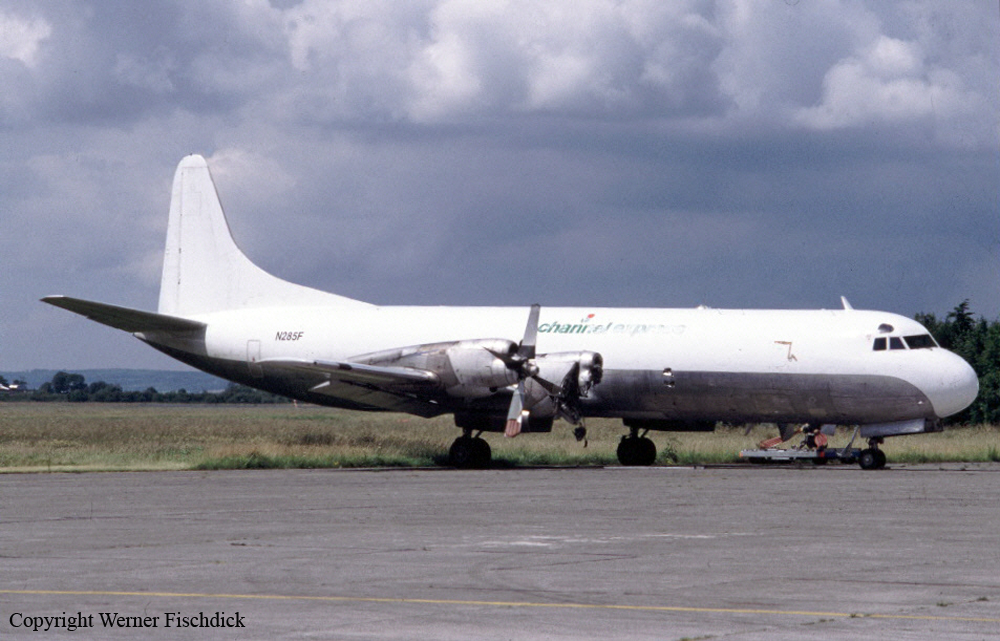

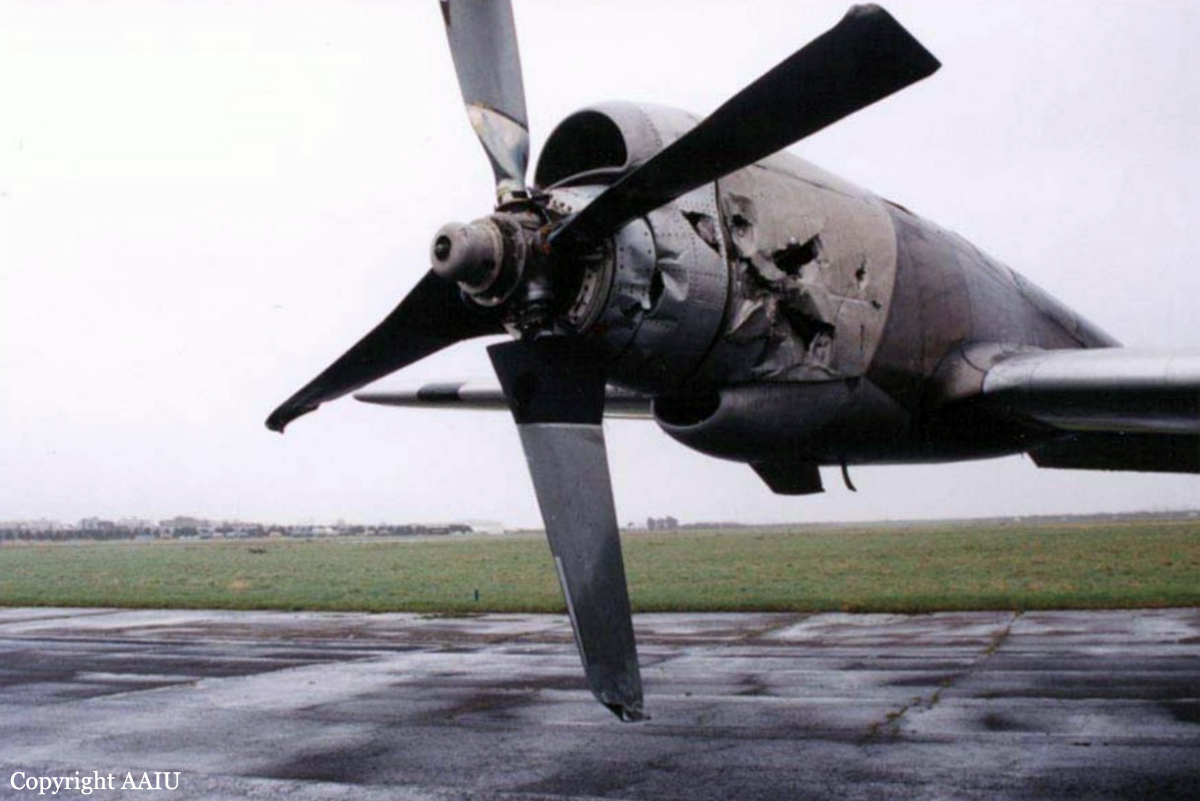
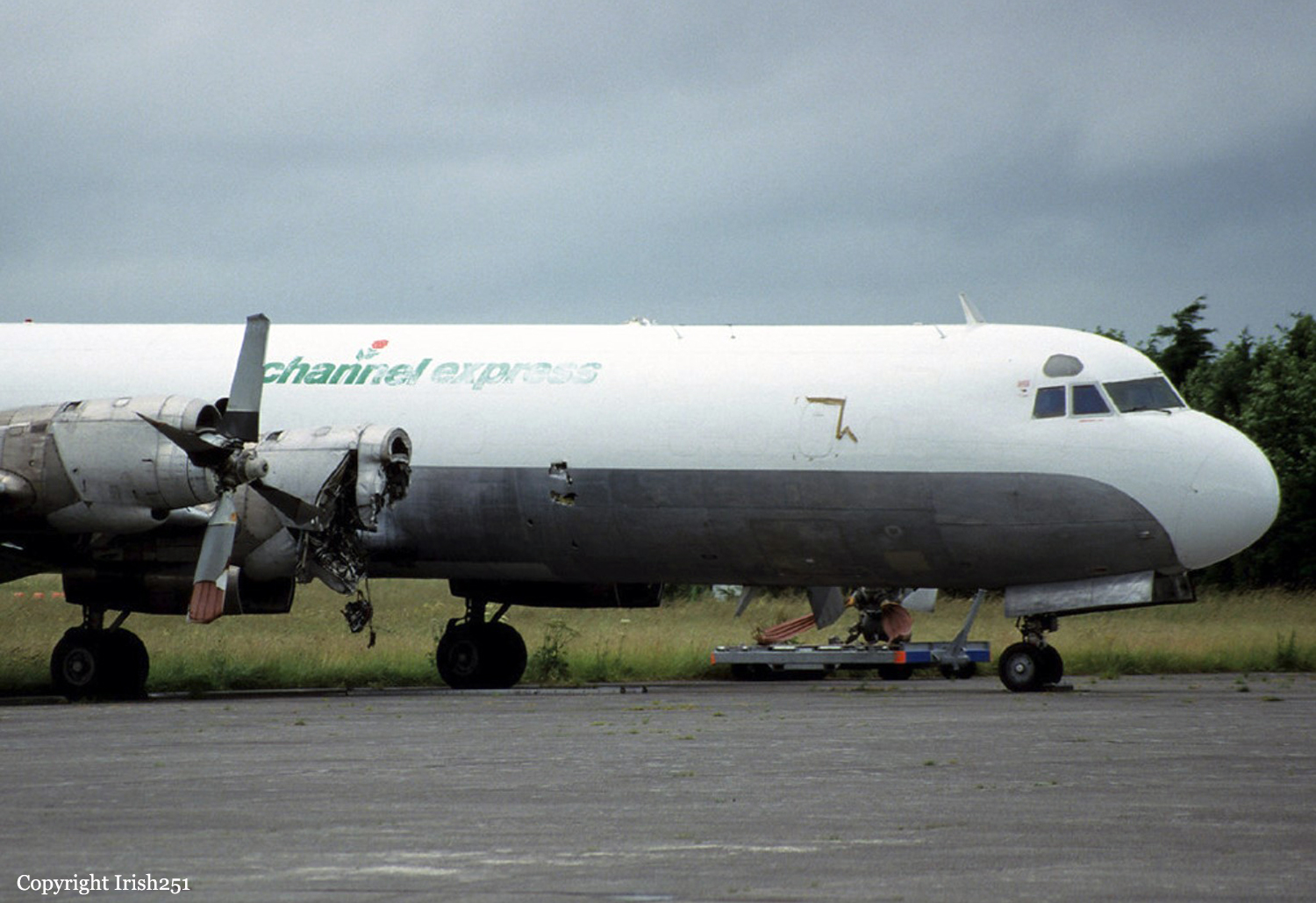
Crash of a Short 360-100 in East Midlands
Date & Time:
Jan 31, 1986 at 1851 LT
Registration:
EI-BEM
Survivors:
Yes
Schedule:
Dublin - East Midlands
MSN:
3642
YOM:
1984
Flight number:
EI328
Crew on board:
3
Crew fatalities:
Pax on board:
33
Pax fatalities:
Other fatalities:
Total fatalities:
0
Captain / Total hours on type:
123.00
Copilot / Total hours on type:
1240
Aircraft flight hours:
3226
Circumstances:
The Shorts 360 aircraft was scheduled to fly from Dublin (DUB) to East Midlands Airport (EMA) as Aer Lingus flight 328. During the pre-flight briefing the crew learned that at East Midlands the precision radar was unserviceable and that, although the visual approach slope indicators (VASI) had been withdrawn, the precision approach path indicators (PAPI) were operational. The en-route weather was reported as being overcast for the whole journey, with cloud tops at FL70 and a probability of icing when flying in the cloud. There had also been a pilot's report of severe icing between FL30 and FL70 in the Birmingham area, some 30 nm south-west of East Midlands Airport. The terminal area forecast for East Midlands suggested a brisk north-easterly wind and a cloud base of 1200 feet. The aircraft took off at 17:25. The crew report that they exercised the wing and tail de-icing system during the climb to FL 90, the level which had been assigned for the flight, and that at that level they were above the layers of stratiform cloud. Following an uneventful flight, via Wallasey, to the NDB at Whitegate, they were taken under radar control directly towards the airport and given descent clearance, eventually to 3000 feet, to intercept the ILS approach path for runway 09. During the descent and before entering the cloud tops at about FL60, the crew switched on the aircraft's anti-ice system, which heats the windscreen, engine air intakes, propellers, static air vents and pitot probes but, in accordance with normal operating procedure, they did not use the wing and tail de-icing system. At this time, the freezing level (0°C isotherm) was at 1000 feet, the temperature at FL 60 was minus 6°C and the air was saturated. Whilst in the cloud, which according to the non-handling pilot was particularly dense, ice thrown from the propellers was heard striking the side of the aircraft fuselage, and it was suggested that the propeller rpm be increased to expedite the removal of the ice. Both pilots state that, at some time during the descent, they visually checked the aircraft for ice but saw none. Nevertheless, several other flights during that evening have since reported the occurrence of severe icing. Having levelled at 3000 feet, still in and out of cloud, the aircraft was directed by radar to intercept the ILS and was fully established on the glideslope and centreline by 10 nm, at which point the final descent was initiated. A normal approach was established and continued, past the outer marker beacon situated at 3.9 nm from touchdown, down to around 1000 feet above the runway threshold height. The crew state that up to this point they had neither experienced any significant turbulence nor observed any ice forming on the aircraft. The last meteorological information passed to the crew gave the wind as 060 degrees /15 kt, however, over the previous hour the wind speed in the area, although not automatically recorded at the airport, is reported as gusting up to 30 kt. As the aircraft descended through about 1000 feet, it suddenly rolled very sharply to the left without apparent cause. With the application of corrective aileron and rudder the aircraft rolled rapidly right, well beyond the wings level position. This alternate left and right rolling motion continued with the angles of bank increasing for some 30 seconds, causing the commander to believe that the aircraft might roll right over onto its back. The angles of bank then gradually decreased. During this period and the subsequent few seconds the aircraft established a very high descent rate approaching 3000 feet/min. Subsequently, with the aid of full engine power, the airspeed increased and the rate of descent was arrested just as the aircraft struck an 11 KV power cable. It continued through another similar cable, two of the supporting wooden poles and the tops of two trees, before coming to rest nose into a small wood edging a field of barley, some 460 metres from the impact with the first power cable. The cockpit and passenger cabin were relatively undamaged and there was no fire. The aircraft came to rest lying virtually upright and the passengers, and subsequently the crew, successfully evacuated from the front and rear emergency exits.
Probable cause:
The accident most probably occurred as a result of the effects of a significant accumulation of airframe ice degrading the aircraft's stability and control characteristics, such that the crew were unable to maintain control. Turbulence and or downdraught may have contributed to the accident. Other contributory factors were the difficulty in detecting clear ice at night on the SD3-60 which resulted in the airframe de-icing system not being used. The delay in application of go-around power may have also contributed to the accident.
Final Report:
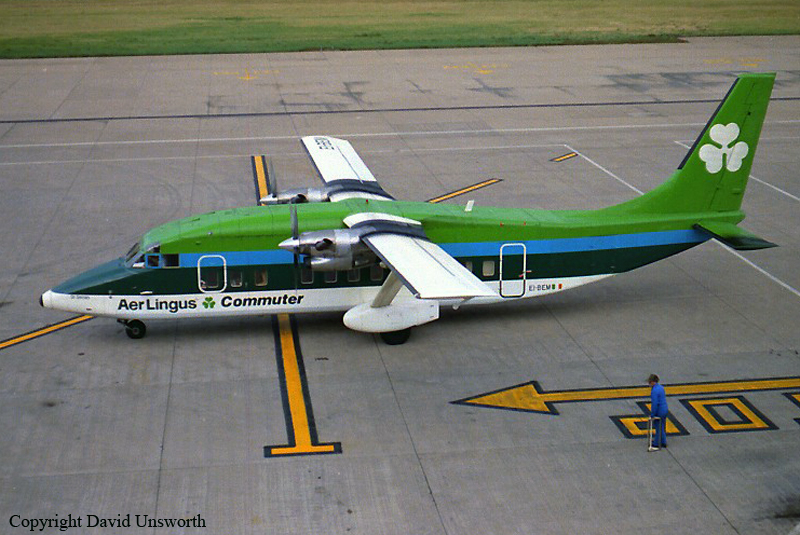
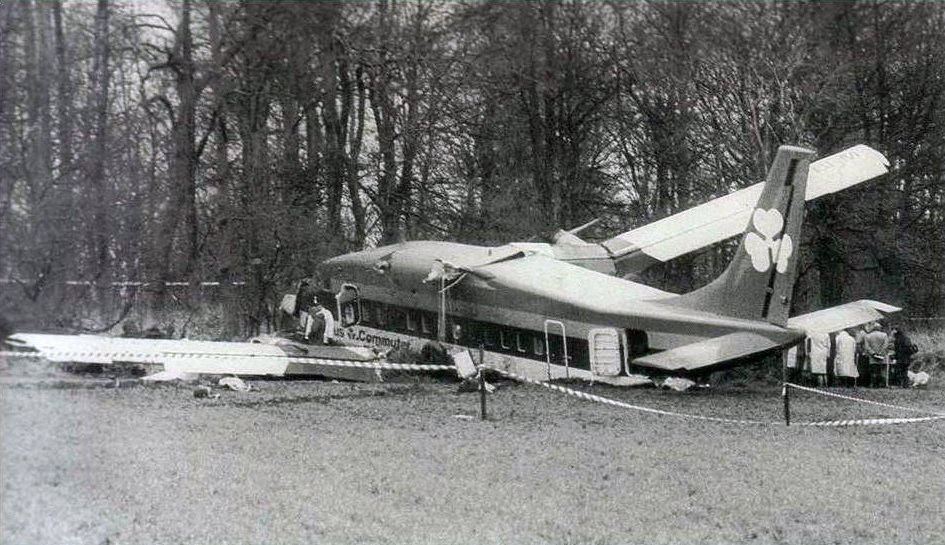
Crash of a Rockwell Grand Commander 690B in Eastbourne: 9 killed
Date & Time:
Nov 13, 1984 at 1841 LT
Registration:
EI-BGL
Survivors:
No
Schedule:
Dublin - Paris
MSN:
690-11507
YOM:
1977
Crew on board:
1
Crew fatalities:
Pax on board:
8
Pax fatalities:
Other fatalities:
Total fatalities:
9
Captain / Total hours on type:
150.00
Aircraft flight hours:
2390
Circumstances:
The aircraft was flying from Dublin to Paris (Le Bourget) at a height of 25,000 feet. In the area of Petersfield, Hampshire, the aircraft began a gentle turn to the left from a south easterly heading. After the radar controller queried the departure from the expected heading the commander reported that the autopilot had 'dropped out', and the south easterly heading was resumed. Approximately 7 minutes later, the radar recording shows that the aircraft again began to turn left and started to lose height. After the aircraft had reached a northerly heading it began to lose height rapidly following which secondary radar returns were lost and the primary returns became fragmented before they also disappeared. The aircraft suffered an in-flight disintegration at approximately 19,000 feet and all 9 occupants were killed. A positive cause of the accident was not determined but there was evidence that a part of the aircraft's electrical supply had been lost. This would have caused the autopilot to disengage and also have resulted in the failure of the commander's flight director indicator. It was concluded that, following the disengagement of the autopilot, the aircraft probably entered a steep spiral dive and that the disintegration of the aircraft occurred as recovery was attempted.
Probable cause:
The in-flight disintegration of the aircraft was probably caused by over-stressing during an attempted recovery from an extreme attitude in a spiral dive. A probable contributory factor was the commander's lack of awareness of the loss of the 26 volt AC supply to the autopilot and flight director system.
Final Report:
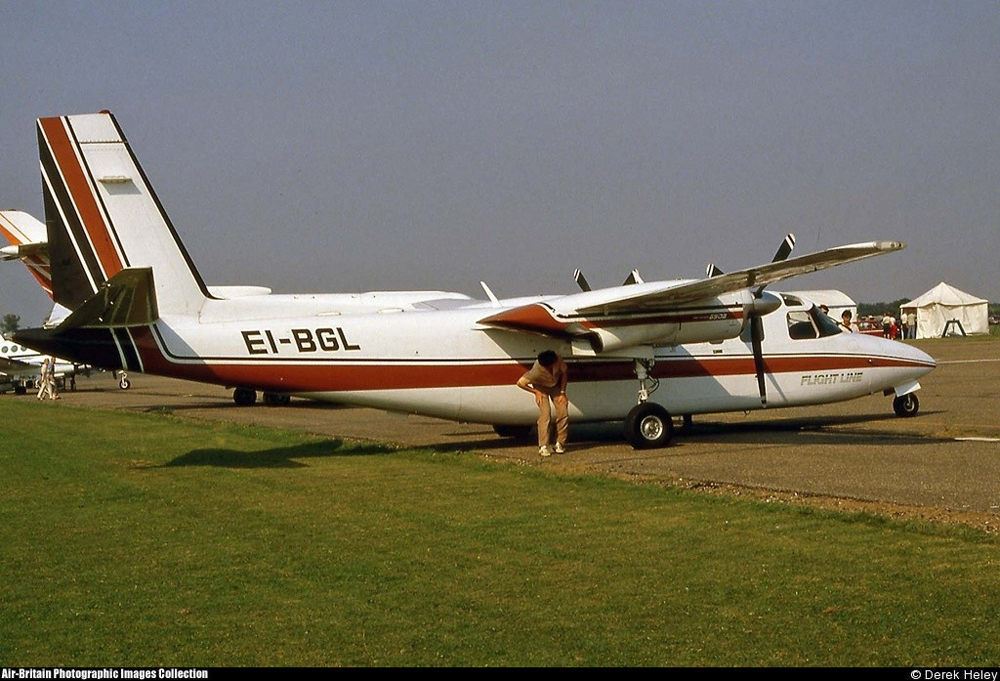
Crash of a Partenavia P.68B near Lydd: 3 killed
Date & Time:
Jan 22, 1979
Registration:
G-BEUT
Survivors:
No
Schedule:
Dublin - Lydd
MSN:
97
YOM:
1977
Crew on board:
1
Crew fatalities:
Pax on board:
2
Pax fatalities:
Other fatalities:
Total fatalities:
3
Circumstances:
While approaching Lydd Airport in poor weather conditions, the pilot lost control of the airplane that crashed six miles southwest of the airfield. The aircraft was destroyed and all three occupants were killed.
Probable cause:
Loss of control while conducting a non precision approach in a snowstorm.
Crash of a Douglas DC-7CF in Luton
Date & Time:
Mar 3, 1974 at 0108 LT
Registration:
EI-AWG
Survivors:
Yes
Schedule:
Dublin - Luton
MSN:
45471/965
YOM:
1958
Crew on board:
4
Crew fatalities:
Pax on board:
6
Pax fatalities:
Other fatalities:
Total fatalities:
0
Captain / Total hours on type:
1185.00
Copilot / Total hours on type:
144
Aircraft flight hours:
27838
Circumstances:
The aircraft was operating a charter flight from Dublin to Luton, loaded with newspapers and equipment necessary for the conveyance of horses back to Dublin. The passengers were six grooms who were intended to accompany the horses on the return flight. During the uneventful flight from Dublin to the Luton area the pilot received a surface wind forecast for Luton of 300/06 knots. At midnight contact was established with Luton Approach. The pilot was given the Luton landing conditions as: 'QNH 1013.5, CAVOK, (ceiling and visibility OK) surface wind practically calm' and asked if he would accept radar positioning for a visual approach to runway 08, to which he agreed. The radar positioning was terminated at 00.04 hrs when the aircraft was cleared to Luton tower frequency with 'Six track miles to run' and the runway in sight. When the pilot contacted Luton Tower at 00.05 hrs, he was cleared to land on runway 08 and given the surface wind as 300 degrees 04 knots. He acknowledged this last transmission and there was no further communication with the aircraft. The evidence indicates that the approach path and speed were normal. The commander did not notice the Indicated Air Speed (IAS) immediately before touchdown but recalled that the initial approach was made at approximately 130 knots IAS reducing to the target threshold speed of 115 knots as the flaps extended. The aircraft touched down at an IAS of 105 knots. The commander was of the opinion that, despite a tendency to float, the aircraft touched down at the correct distance down the runway, and, as soon as it had done so, he called for reverse thrust immediately the aircraft was on the runway. On receiving the commander's order, the engineer selected reverse thrust on numbers 2 and 3 engines followed by numbers 1 and 4 whilst monitoring the engine instruments. The commander was familiar with this method of selecting reverse which was the technique normally used in the company. The flight engineer did not see the blue warning lights illuminate to indicate that the propellers were moving into reverse pitch, he therefore selected Nos 1 and 4 propellers to forward pitch, with throttles closed, in case the reason for the malfunction was an electrical overload due to operation of all four feathering/reversing pumps at low engine rpm. The commander had also noticed that the blue lights had not illuminated and, seeing that Nos 1 and 4 propellers were selected to forward pitch, called 'reverse all engines'. In response to his order the engineer made the required selection and all four throttle levers were seen to be in the reverse quadrant by the operating crew, although no blue lights were noted. The aircraft was not decelerating during this period and that no reverse thrust was achieved. The commander ordered the engineer to 'put them in the middle', thus to cancel the reverse thrust selections. There were two short periods of engine acceleration during the landing roll. The commander assisted by the first officer applied the toe brakes, assessed them to be ineffective and, as the aircraft was still not decelerating, applied the emergency pneumatic brakes by turning the operating handle to 'on'. The commander did not notice any deceleration and, consequently, did not follow the procedure of selecting them alternatively to 'hold' and to 'on'. All four main wheels locked, the tyres burst and further retardation from the brakes was lost. Sparks and smoke were seen emanating from the area of the undercarriage when the aircraft approached the end of the runway. When it became apparent that the aircraft would overrun the runway the commander called to have the 'switches' put to 'OFF'. The flight engineer selected the ignition switches off before the aircraft left the end of the runway and ploughed across the overrun area. It was still travelling fast enough to follow a trajectory off the top of the bank at the end of the runway leaving no wheel marks down the slope. The aircraft stopped in soft ground 90 metres from the end of the runway at the foot of the bank having demolished part of the aerodrome fence and some of the approach lights. All persons on board abandoned the aircraft without delay. As the flight engineer was leaving via the right hand side crew door, he noticed a small fire under the number 3 engine. He returned to the cockpit, pulled the firewall shut-off controls and discharged a fire extinguisher to all four engines.
Probable cause:
Failure to achieve reverse thrust after touchdown and an inadvertent application of forward thrust during the landing roll. The resulting overrun was aggravated by the operation of the emergency pneumatic brakes which resulted in the bursting of all four main wheel tires with consequent loss of braking capacity.
Final Report:
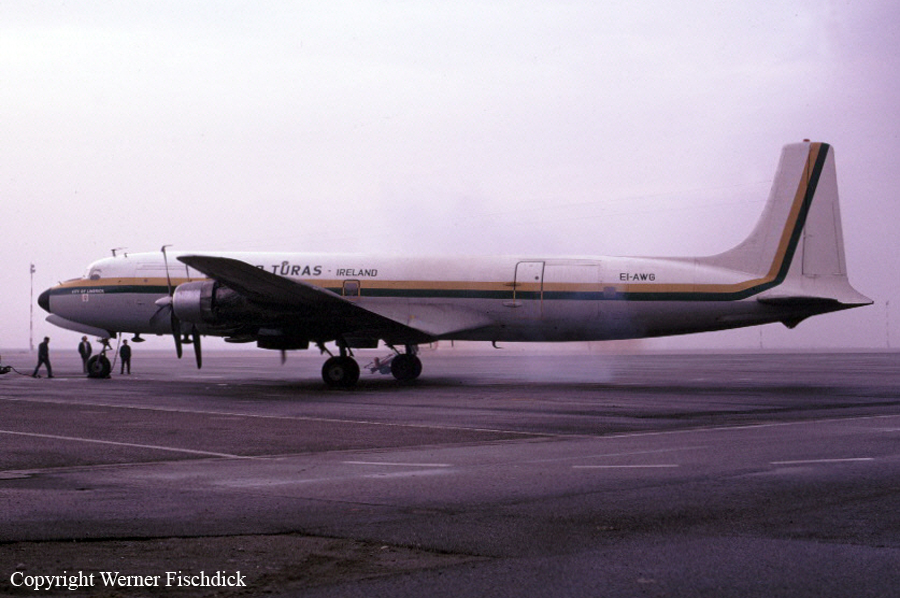
Crash of a Vickers 808 Viscount in Bristol
Date & Time:
Sep 21, 1967 at 0859 LT
Registration:
EI-AKK
Survivors:
Yes
Schedule:
Dublin - Bristol
MSN:
422
YOM:
1959
Crew on board:
4
Crew fatalities:
Pax on board:
17
Pax fatalities:
Other fatalities:
Total fatalities:
0
Captain / Total hours on type:
1300.00
Copilot / Total hours on type:
592
Aircraft flight hours:
18375
Circumstances:
Before leaving Dublin no landing forecast for Lulsgate was available but the forecast conditions for Filton, 10 miles north of Lulsgate, were well above the company minima of 260 ft critical height and 800 rn RVR. About 25 minutes before commencing the approach to land and whilst the aircraft was on the airway near Strumble, the latest weather conditions for Lulsgate obtained by radio from air traffic control, showed that there was 3/8 cloud at 1 000 ft, visibility was 1 500 m with the sun tending to disperse cloud and mist. After leaving the airway, the aircraft was positioned by Lulsgate radar for an approach to runway 28 on a right-hand base leg. At 0752 hours GMT before the final approach was commenced, the latest weather conditions were passed by the Lulsgate rabar controller who was also the approach controller, these conditions showed a surface wind northerly 8 to 10 kt, QFE 979, QNH 1 001, visibility in mist 1 800 m. During the final turn on to the approach at 6 miles, the aircraft drifted to the left of the extended centre line which was regained closing from left to right during the final descent. At five miles from touchdown, still to the left of the centre line, a descent from 1 500 ft (QFE) was commenced at a rate of 300 ft per mile with advisory altitudes being passed every half mile. The air was calm and the commander was able to achieve a high degree of precision during the approach; heights were accurately flown during the descent and the aircraft's track, cow verging on the centre line, was steady, When the aircraft was between 3 and 34 miles from touchdown, the controller informed it that visibility had deteriorated to 1 200 m. At two miles, when steering 2950, the aircraft intercepted the approach centre line and its heading was corrected to 290°; at one and a half miles at 500 ft, a further heading correction was made on to 287°. A drift to the right, away from the centre line, became apparent when the aircraft was between 1 and 12 miles from touchdown and the controller gave further corrections to the left to 285° and 280°. At one mile from touchdown at 350 feet, a further left correction to 275° was given but the aircraft continued to track to the right of the centre line. At half a mile from touchdown, when the talk-down was complete, the controller informed the aircraft it was well to the right of the centre line and that it should overshoot if the runway was not in sight. Shortly afterwards the aircraft was seen, by a controller, heading towards the control tower before commencing its corrective turn to the left. The commander, who was at the controls of the aircraft, said it was possible to refer to the ground and natural horizon until passing through about 650 ft when a thin layer of cloud followed by misty conditions required the remainder of the approach to be made on instruments. Whilst descending through 300 ft, the commander asked the co-pilot if he could see anything but just as he replied in the negative the commander saw the approach lights ahead and to his left and he promptly commenced an 'St turn to line up with them. As he did so he called for 400 of flap and less power in order to reduce the airspeed from 130 kt to about 112 kt. During this phase, he lost contact with the lights "for some seconds" but he elected to continue the approach because the last reported visibility was 1 200 rn and he was confident the runway lights would shortly appear ahead. When they came into view the aircraft was over the left-hand side of the runway and not properly aligned with it; the commander said he attempted to turn on to the runway centre line as he flared out for the landing. During this manoeuvre, although he was not aware of it, the starboard wing tip and No. 4 propeller struck the runway; the aircraft then touched down on all its wheels with considerable port drift. The commander took overshoot action, applying full power, calling for 20° of flap and the undercarriage to be raised; the airspeed had, in the meanwhile, fallen below 100 kt. The commander realised that the aircraft was not accelerating normally and saw that it was headed towards buildings on the northern perimeter of the aerodrome; rather than risk flying into these obstructions, he flew the aircraft on to the ground with its undercarriagi retracting. The aircraft touched down starboard wing first, ground-looped tb the right as it slid along the remaining section of the adjacent runway, then crashed tail first through a fence. Ten of the occupants of the passenger cabin were injured, three of them seriously; fire did not break out; rescue and fire vehicles arrived promptly on the scene. The accident occurred at 0759 hours.
Probable cause:
The accident was caused by an attempt to align the aircraft with the runway at too low a height following the commander's incorrect decision to continue the approach when visual guidance became obscured below critical height. A crash landing became necessary during an attempted overshoot after the aircraft had touched the ground and sustained damage during a turn at a low height.
Final Report:




